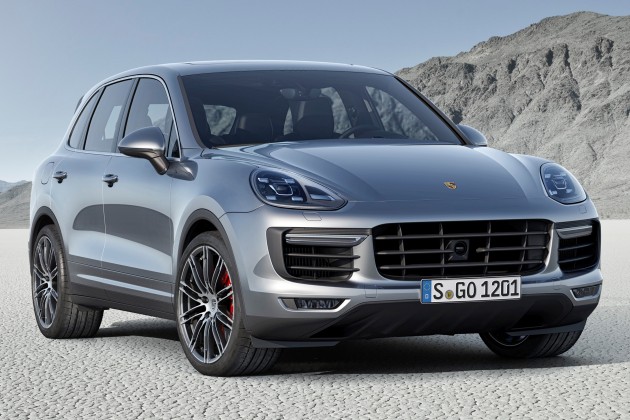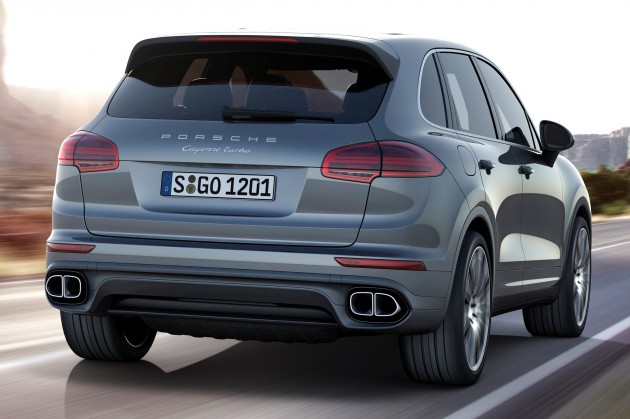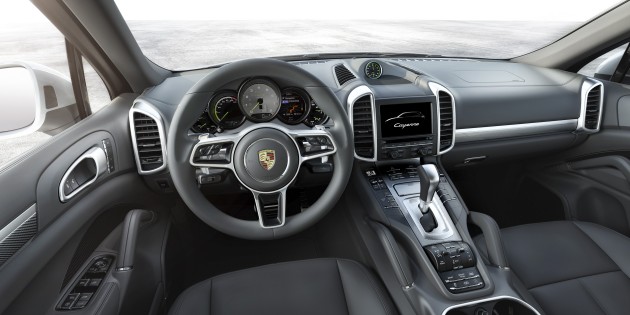
The second-generation Porsche Cayenne has been given a mid-life nip and tuck after four years on the market. Scheduled to make its world debut at the Paris Motor Show in October, the facelift features numerous subtle changes both inside and out, including a new plug-in hybrid model.
Outside, those changes are of the blink-and-you'll-miss-it variety, done to bring the Cayenne closer to the Macan visually. The front air intakes are reshaped and feature new "airblades" on the outer edges of the front end. The headlights are also more angular, and bi-xenon units now come as standard (Turbo models get adaptive full LEDs), while the bonnet has been made larger.
At the rear, the tail lights are narrower, and the internals have been redesigned to give a "three-dimensional effect". The rear number plate recess, rear valence and exhaust outlets have also been reprofiled.
Inside, the Cayenne gets a 918-inspired multi-function steering wheel taken from the Macan. The new wheel includes paddle shifters instead of the old push-to-upshift-pull-to-downshift buttons on either side (proper paddles were previously part of a SportDesign steering wheel option). The rear seats have also been redesigned for better comfort and seat ventilation is now offered as an option.

Under the skin, some tweaks have been made for better efficiency – a new coasting function built into the stop-start system, as well as active flaps in the air intakes enable the Cayenne to use less fuel than before. Tweaks have also been done to the chassis to provide greater comfort without sacrificing the handling.
The Macan Turbo's 3.6 litre twin-turbo V6 supplants naturally-aspirated V8 power in the Cayenne S, producing 414 hp at 6,000 rpm and 550 Nm from 1,350 to 4,500 rpm. 0-100 km/h is now done in 5.5 seconds (5.4 with the Sport Chrono pack), while the top speed is 259 km/h. Fuel consumption is down by 1 litre per 100 km to 9.5 litres per 100 km.
The Cayenne Turbo's existing 4.8 litre twin-turbo V8, on the other hand, has been revised, boosting power to 512 hp at at 6,000 rpm and 750 Nm from 2,250 to 4,000 rpm. Sprinting to 100 km/h in 4.5 seconds (4.4 with Sport Chrono pack) before topping out at 279 km/h, the Turbo nevertheless manages to cut fuel consumption by 0.3 litres per 100 km to 11.2 litres per 100 km.
Diesel engines have also been improved, with the Cayenne Diesel's 3.0 litre turbo V6 now producing 258 hp at 6,000 rpm and 580 Nm from 1,750 to 2,500 rpm. Acceleration from 0-100 km/h is cut to 7.3 seconds (7.2 with Sport Chrono pack) and top speed is up to 221 km/h. Fuel consumption has also been reduced by 0.6 litres per 100 km, sitting at 6.6 litres per 100 km.

The more powerful Cayenne S Diesel's 4.2-litre V8 engine has been massaged to produce 380 hp at 3,750 rpm, while torque remains an immense 850 Nm from 2,000 to 2,750 rpm. It now blasts to 100 km/h in 5.4 seconds (5.3 seconds with Sport Chrono pack) up to a top speed of 252 km/h. Fuel consumption is listed at 8.0 litres per 100 km, down 0.3 litres per 100 km.
New to the range is a plug-in Cayenne S E-Hybrid – the third Porsche plug-in hybrid after the Panamera S E-Hybrid and the 918 Spyder – which replaces the S Hybrid in the lineup. The existing 328 hp, 440 Nm 3.0 litre supercharged V6 is now mated with an electric motor with more than double the power – 70 kW (94 hp) – and a 10.9 kWh lithium-ion battery.
Combined, they produce some impressive figures: 416 hp at 5,500 rpm, 590 Nm from 1,250 to 4,000 rpm, a 0-100 km/h time of 5.9 seconds and a top speed of 243 km/h. Fuel consumption, meanwhile, is down to just 3.4 litres per 100 km, a whopping 59% drop from the S Hybrid. An all-electric range of between 18 and 36 km is quoted, at speeds below 125 km/h.



No comments:
Post a Comment